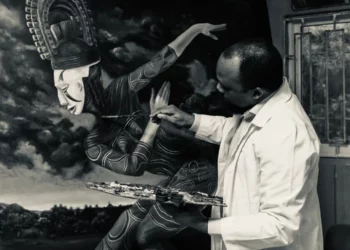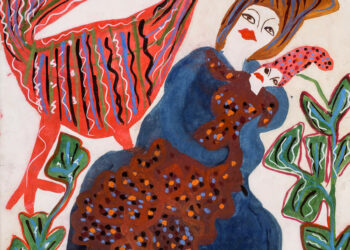Tiwani Contemporary announces their forthcoming presentation, ‘Dawit L. Petros: Recollections’. The exhibition continues Petros’ inquiries into the complex relationship between African and European histories of colonialism and modernity.

Dawit L. Petros, ‘Recollections & Contrasting Notions, (Battalion 36)‘, 2023, serigraphs on Arnhem paper, 76 x 56 cm. Edition of 3 plus 2 artist’s proofs. Courtesy of the artist and Tiwani Contemporary.
The Strangers Notebook (2016-2017) the project which formed Petros’ debut solo show with Tiwani Contemporary, in 2016, emerged from a thirteen-month journey the artist made across Africa and Europe. It addressed the West’s limited knowledge of extensive cross-border flows and diasporas within the African continent. Spazio Disponibile, (2019-2020), Italian for “available spaces”, examined connections and patterns of movement in the interconnected material histories of Eritrea, Italy, and Canada. Prospetto a Mare (2021-Present) expands the implications of this North American, European and North American configuration by adding the itineraries of Alitalia – Fascist Italy’s civil airline – and the trans-Atlantic crossings of General Italo Balbo. Prospetto a Mare uses photography, video, and sound to examine the powerful role that aviation technologies played in the construction of Italy’s colonial vision.
‘Dawit L. Petros: Recollections‘ draws from and extends the third in this trio of projects. In this exhibition selected works highlight colonial publications that the artist has been collecting since 2010 – maps, aeronautic manuals, postcards, and photographs. These are reimagined and converted into multi-scalar works across an array of media. A monumental mural manifests an imperial structure in unstable, ambiguous ways. A wall sculpture proposes a form for contested territorial claims. Performative, staged photographs juxtapose subjects with charged, symbolic landscapes. These acts of appropriation and transformation are gestures of cultural and ideological resistance intended to reveal the ambiguities and dissonances inherent to colonial documents.
Petros’ aesthetics are anchored on the visual syntax of abstraction. The language of the exhibition brings together highly representational images – for example, a photograph of a figure in the landscape, or a mural of a crane – in proximity to spare iconography (serigraphs, a sculpture). Abstraction and figuration are posited in open, unresolved tensions that point towards pluralities of readings. Furthermore, the restrained visual forms pose questions about aesthetic beauty and what kind of visual language is most appropriate for analysing charged colonial histories.
The exhibition opens with Strategic Withdrawal, Central Sector, 1900, Number 3 (2023), a wall sculpture constructed from polished stainless steel. The work commemorates the 1998-2000 border conflict between Eritrea and Ethiopia. Cartographic discrepancies in colonial era maps were significant catalysts for the war. Therefore, the sculpture reflects the ways in which western dominance in the Horn of Africa transformed the paradigms through which the region developed.
Recollections (Contrasting Notions), 2023 are serigraphs which explore popular representations of Eritrean askari, indigenous troops recruited into Italy’s colonial army. The sources for the work are postcards and illustrated magazines which served to consolidate the colonial imaginaries necessary for the creation of Italy’s empire. The vertical bands of colour and the numerical designation of each title reference the battalions under which askaris served. Beneath the bands of colour are sections of images extracted from the illustrated postcards. The result fuses abstract, expressive impulses with those of the document. What emerges is a nod towards multiple, paradoxical acts of reading documents and the subjects that they depict.
In 2021’s Istruzioni (Transits, Trajectories, Invisible Networks) serigraphs, Petros investigates the geographic imaginations formulated through Italian military and civil aviation. The serigraphs are sourced from the 1931 technical manual for the Isotta Fraschnini – better known as the Asso 750 – the engine which powered Italy’s Savoia-Marchetti-S. 55X hydroplane. The manual is illustrative of fascist iconography with its limited, ordered set of images, forms, and austere tone. The beauty with which fascism and futurism took pride in the mechanical workings of industrial forms are powerfully visible. Istruzioni (Transits, Trajectories, Invisible Networks) challenges these aesthetics that continue to linger in these objects and their representations.
Spectral Fragment (2023), revisits a monumental four-panel work, Spectre (Floating Dock) (2021) in which the landscape of colonial Eritrea is emblematised through images of a steel dock. The current iteration reimagines and rematerialises the visual and visceral impact of an imposing structure central to the movement of goods into the port of Massawa and the broader Italian East African empire. The work is an amalgamation of historical photographs rendered in a quivering reproduction akin to drawing. The experience produced thwarts desires for transparency and totality. Spectral Fragment, 2023 marks a return of the structure and important questions which have remained from view. Following Italy’s defeat in WWII, Britain established a 10-year administration of Eritrea (1941-1950). During this period and in contravention of international law, Britain dismantled and transported highly valuable infrastructures – including the floating dock – to its other colonies.
The exhibition concludes with Untitled (Epilogue VIII), Longueuil, Quebec (2021). Epilogues continue Petros’ longstanding motif of subjects in the landscape holding mirrors against their faces. These mirrors confer anonymity to the subjects while offering viewers a different reflected lens by which to view reality. In these four photographs young asylum seekers from Eritrea who fled Italy due to its inability to provide protection and opportunities, stand in various locations around Montreal, Quebec. The sites range from Roxham Road (the border which these subjects crossed on foot from the US into Canada), Longueil Harbour (where Italo Balbo’s fleet of planes landed in 1933), and the Casa d’Italia (a community centre built in 1933 by the Italian community and Mount Royal).
Petros’ artistic initiative is an urgent one. By directing attention to historical analysis that ties Italy’s contemporary rise of ethnonationalism to its colonial past, his current project reflects the role that cultural production can exert towards more expansive understandings of the present.
The exhibition will be on view from the 5th until the 29th of July, 2023. For more information, please visit Tiwani Contemporary.



